
The Siberian Husky is a medium-sized working sled dog breed. The breed belongs to the Spitz genetic family. It is recognizable by its thickly furred double coat, erect triangular ears, and distinctive markings, and is smaller than the similar-looking Alaskan Malamute.

The Iditarod Trail Sled Dog Race is an annual long-distance sled dog race run in early March from Anchorage to Nome, entirely within the US state of Alaska. Mushers and a team of 14 dogs, of which at least 5 must be on the towline at the finish line, cover the distance in 8–15 days or more. The Iditarod began in 1973 as an event to test the best sled dog mushers and teams but evolved into today's highly competitive race.
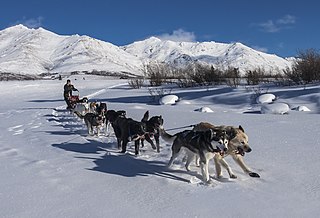
A sled dog is a dog trained and used to pull a land vehicle in harness, most commonly a sled over snow.

Sled dog racing is a winter dog sport most popular in the Arctic regions of the United States, Canada, Russia, Greenland and some European countries. It involves the timed competition of teams of sled dogs that pull a sled with the dog driver or musher standing on the runners. The team completing the marked course in the least time is judged the winner.
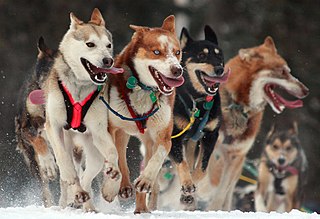
Mushing is a sport or transport method powered by dogs. It includes carting, pulka, dog scootering, sled dog racing, skijoring, freighting, and weight pulling. More specifically, it implies the use of one or more dogs to pull a sled on snow or a rig on dry land.
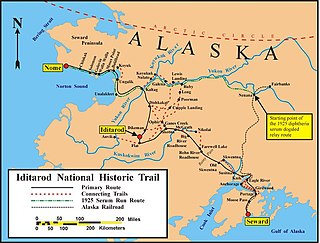
The Iditarod Trail, also known historically as the Seward-to-Nome Trail, is a thousand-plus mile (1,600 km) historic and contemporary trail system in the US state of Alaska. The trail began as a composite of trails established by Alaskan native peoples. Its route crossed several mountain ranges and valleys and passed through numerous historical settlements en route from Seward to Nome. The discovery of gold around Nome brought thousands of people over this route beginning in 1908. Roadhouses for people and dog barns sprang up every 20 or so miles. By 1918 World War I and the lack of 'gold fever' resulted in far less travel. The trail might have been forgotten except for the 1925 diphtheria outbreak in Nome. In one of the final great feats of dog sleds, twenty drivers and teams carried the life-saving serum 674 miles (1,085 km) in 127 hours. Today, the Iditarod Trail Sled Dog Race serves to commemorate the part the trail and its dog sleds played in the development of Alaska, and the route and a series of connecting trails have been designated Iditarod National Historic Trail.

Gunnar Kaasen was a Norwegian-born musher who delivered a cylinder containing 300,000 units of diphtheria antitoxin to Nome, Alaska, in 1925, as the last leg of a dog sled relay that saved the U.S. city from an epidemic.

Togo was the lead sled dog of musher Leonhard Seppala and his dog sled team in the 1925 serum run to Nome across central and northern Alaska. Despite covering a far greater distance than any other lead dogs on the run, over some of the most dangerous parts of the trail, his role was left out of contemporary news of the event at the time, in favor of the lead dog for the last leg of the relay, Balto, whom Seppala also owned and had bred.
Joe Redington, Senior was an American dog musher and kennel owner, who is best known as the "Father of the Iditarod Trail Sled Dog Race", a long distance sled dog race run annually from the Anchorage area to Nome, Alaska.
Dorothy G. Page was best known as "Mother of the Iditarod Trail Sled Dog Race", the 1,049-mile dog sled race across the U.S. state of Alaska.

The 1925 serum run to Nome, also known as the Great Race of Mercy and The Serum Run, was a transport of diphtheria antitoxin by dog sled relay across the U.S. territory of Alaska by 20 mushers and about 150 sled dogs across 674 miles (1,085 km) in 5 ½ days, saving the small town of Nome and the surrounding communities from a developing epidemic.

Leonhard "Sepp" Seppala was a Norwegian sled dog breeder, trainer and musher who with his dogs played a pivotal role in the 1925 serum run to Nome, and participated in the 1932 Winter Olympics. Seppala introduced the work dogs used by Native Siberians at the time to the American public; the breed came to be known as the Siberian Husky in the English-speaking world. The Leonhard Seppala Humanitarian Award, which honors excellence in sled dog care, is named in honour of him.

Ramy "Ray" Brooks is an Alaska Native kennel owner and operator, motivational speaker, and dog musher who specializes in long-distance races. He is a two-time runner up in the 1,049+ mi Iditarod Trail Sled Dog Race across the U.S. state of Alaska, and a former winner of the 1,000 mi (1,600 km) Yukon Quest dog sled race across both Canada and the U.S.
The American Dog Derby is a dogsled race held in Ashton, Idaho, on the third weekend of February. It is the oldest dogsled race in the United States. The first American Dog Derby was held in 1917. It was tremendously popular in the 1920s through the 1950s. Interest waned in the 1960s and the race was discontinued for several years. It was revived in 1993 and continues to grow in popularity.
The Hope Race or Hope Sled Dog Race is a defunct international sled dog race between Nome, Alaska and Anadyr, Russia, across the Bering Strait. The race was established in 1991, shortly after the fall of the Soviet Union, and according to information on the race's Web site, was run as recently as 2004. Racers covered 1,200 miles, but did not actually race across the Bering Strait. Teams instead were shipped across the strait on boats and raced on land. In 1995, Alaska musher Bob Holder became the only person to compete in the Hope Race, Iditarod Trail Sled Dog Race, and Yukon Quest in the same year.

Aliy Zirkle is an American champion of sled dog racing.

Allan Alexander "Scotty" Allan, born in Dundee in 1867, who died in 1941, was a Scottish-born American dog musher, businessman and politician.
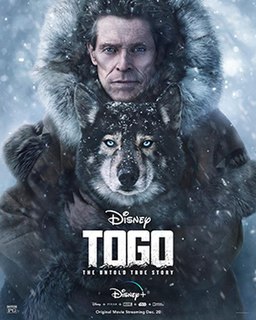
Togo is a 2019 American drama adventure film directed by Ericson Core and produced by Walt Disney Pictures. The film centers on Leonhard Seppala and his titular sled dog in the 1925 serum run to Nome to transport diphtheria antitoxin serum through harsh conditions during an epidemic of diphtheria.
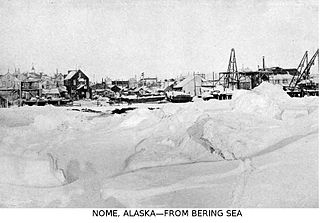
Esther Birdsall Darling was an American author and poet; she also opened and ran a sled dog kennel in Alaska.
















